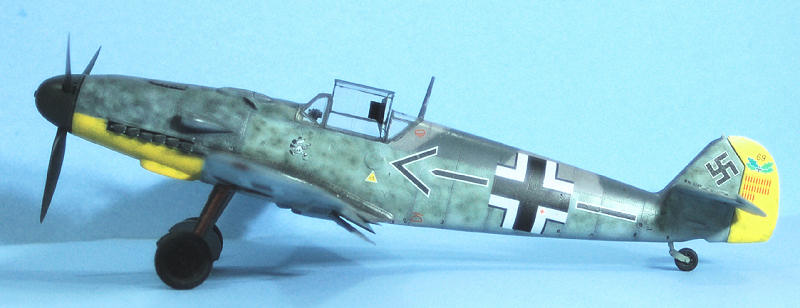
Trumpeter 1/32 Bf-109F-2
| KIT #: | 02292 |
| PRICE: | $63.00 MSRP |
| DECALS: | Two options |
| REVIEWER: | Tom Cleaver |
| NOTES: | Aires Bf-109F-2 resin conversion parts used. |

| HISTORY |
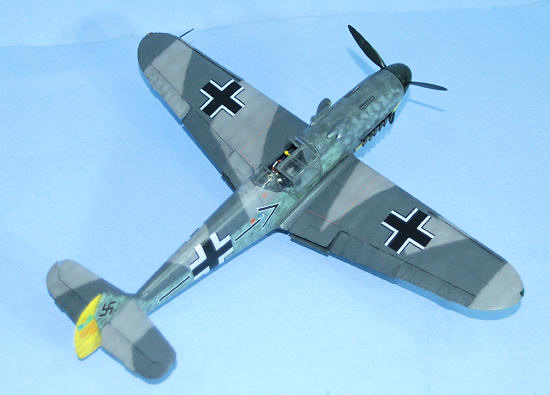
Galland’s two brothers
also became fighter pilots and aces before being killed in combat: Paul
Galland was killed on October 31, 1942 when he was shot down by a Spitfire
after scoring 17 victories, while Wilhelm‑Ferdinand “Wutz” Galland - who had
followed his older brother to a position of command responsibility within JG
26 - was shot down and killed on August 17, 1943 after scoring 54 victories.
Promoted to Hauptmann
just prior to the outbreak of World War II, Galland became Staffelkapitän
of 4.(S)/Lehrgeschwader 2, equipped with the Henschel Hs‑123, He flew
an average of four sorties a day during the Polish campaign and was awarded
the Iron Cross Second Class.
Prevented from joining the Jagdwaffe on the grounds he was too
experienced in ground attack, Galland falsely claimed he had rheumatism and
could no longer fly in open cockpit aircraft, and was transferred from his
post on medical grounds.
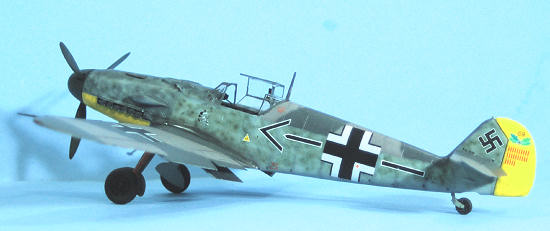
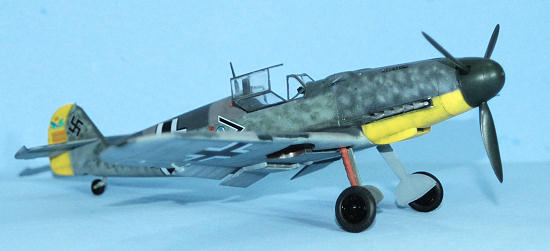 development
in armament was likely due to the fact that his vision was not the equal of
Mölders, due to the glass shards he in his eyes as a result of his two
flying accidents. Galland
continued to fly his Bf‑109E‑4 on missions, though he also took delivery of
a Bf-109F-0. He later was given
two special Bf-109Fs in the summer of 1941 ‑ one with a unique armament of
an MG 151/20 cannon and two cowl‑mounted 13 mm MG 131s, with the other
equipped with integral wing‑mounted 20 mm MG‑FF cannons and cowl‑mounted MG
17s. (In the late 1960s and early 1970s, the scale model experten believed
Galland had one airplane, equipped with the engine mounted cannon, 13mm
machine guns, and wing‑mounted cannon.
Thomas Hitchcock disproved this by publishing photos of both
airplanes in his “109 Gallery” in 1972.)
development
in armament was likely due to the fact that his vision was not the equal of
Mölders, due to the glass shards he in his eyes as a result of his two
flying accidents. Galland
continued to fly his Bf‑109E‑4 on missions, though he also took delivery of
a Bf-109F-0. He later was given
two special Bf-109Fs in the summer of 1941 ‑ one with a unique armament of
an MG 151/20 cannon and two cowl‑mounted 13 mm MG 131s, with the other
equipped with integral wing‑mounted 20 mm MG‑FF cannons and cowl‑mounted MG
17s. (In the late 1960s and early 1970s, the scale model experten believed
Galland had one airplane, equipped with the engine mounted cannon, 13mm
machine guns, and wing‑mounted cannon.
Thomas Hitchcock disproved this by publishing photos of both
airplanes in his “109 Gallery” in 1972.)
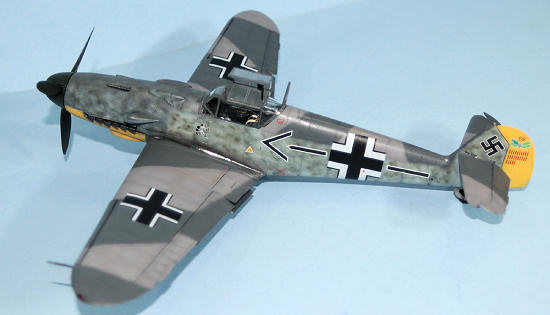 swung
twice before hitting the ground. Arriving back at the base that evening, he
found he had become the first member of the Wehrmacht to be awarded the
Eichenlaub to the Ritterkreuz for his 70th victory.
swung
twice before hitting the ground. Arriving back at the base that evening, he
found he had become the first member of the Wehrmacht to be awarded the
Eichenlaub to the Ritterkreuz for his 70th victory.
Galland had always flown
without the extensive head armor found on the Bf‑109, which he believed was
not worth the increased protection due to the fact it restricted rear vision
so badly. On July 2, 1941, with
his own fighter being repaired, he led JG 26 into combat against a formation
of Blenheims in another aircraft. A Spitfire from 308 Squadron hit Galland's
plane with a 20 mm shell in the rear of the canopy, and his life was saved
by the armor plate. After that,
he finally equipped his own airplane with the head armor.
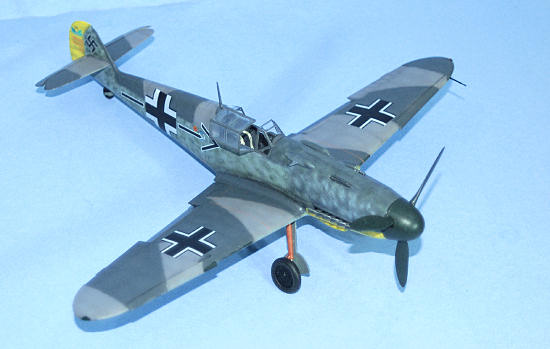
| THE KIT |
Trumpeter seems to have
trouble getting the Bf-109 right, starting back with their 1/24 Bf-109G kits
from several years ago and continuing through their recently-released 1/32
Bf-109E-3. This kit continues
that tradition. While the box
lid proclaims it a Bf-109F-4, it is much closer in all ways to a Bf-109G-2,
and a modeler could do this version without much additional effort past
getting a corrected rudder.
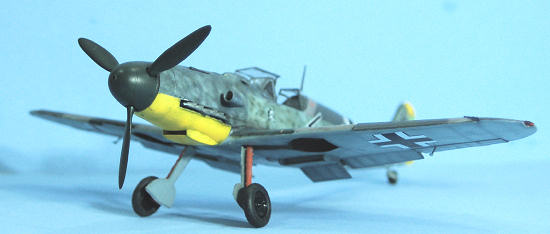 designer
had used this photo - without noticing the “notch” between the upper part of
the rudder and the vertical fin, which denotes the fact that the rudder is
turned about 10-15 degrees toward the viewer, thus changing the outline
shape considerably. One can
either obtain a correct rudder from the aftermarket, rob an older kit, or do
what I did, which was to use Evergreen sheet to add the additional area to
the rudder to get the correct shape.
designer
had used this photo - without noticing the “notch” between the upper part of
the rudder and the vertical fin, which denotes the fact that the rudder is
turned about 10-15 degrees toward the viewer, thus changing the outline
shape considerably. One can
either obtain a correct rudder from the aftermarket, rob an older kit, or do
what I did, which was to use Evergreen sheet to add the additional area to
the rudder to get the correct shape.
| CONSTRUCTION |
I wanted to see if the
problems associated with this kit were the kind that can be overcome with
“some modeling skill” required.
I wanted an early Bf-109F-2, so I decided to pull out the resin Bf-109F-2
conversion set I had been given by Bernard Payne, which
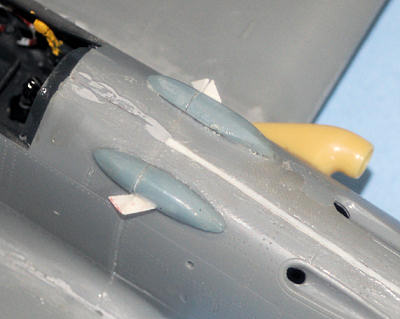 provides
the narrow-chord propeller blades, the shallower oil cooler, and the smaller
supercharger air intake (all of which fit this kit without problems).
provides
the narrow-chord propeller blades, the shallower oil cooler, and the smaller
supercharger air intake (all of which fit this kit without problems).
While I was at it, I
realized I had decals with the markings for a Galland Bf-109E-4, which were
also used on his two Bf-109F-2/U “specials.”
I decided to do the “special” with the heavier machine guns, using
some parts from the spares box to create the fairings for the 13mm machine
guns.
Given that the ultimate
destination of this model is the Planes of Fame Museum, where viewers won’t
be looking in the cockpit, I didn’t put a whole lot of effort at modifying
that area of the model, though one would have to at least change the
instrument panel to get an “F” cockpit.
It is nice that the kit provides the separate seat back that was used
in the Bf-109F.
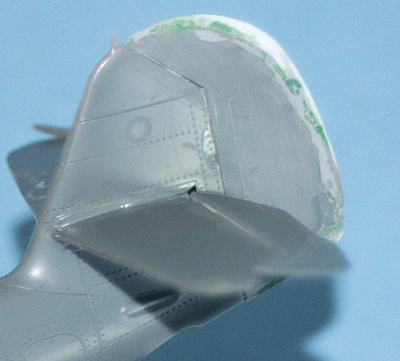 Other
than the modification for the weapons, the other big correction effort
involved correcting the shape of the rudder with Evergreen sheet.
I also sanded off the extra framing of the canopy and then polished
that out - I would recommend to any modeler who wants to turn this into an
“F” that they get hold of the True Details (Falcon) 1/32 Bf-109E canopy,
which is also correct for the Bf-109F and which looks like it will fit this
kit without a lot of problems.
As long as you’re at it, you might also want to get the True Details Bf-109E
wheels, which look far better than what the kit provides, which look like
they followed Eduard in making too-shallow wheel hubs.
Other
than the modification for the weapons, the other big correction effort
involved correcting the shape of the rudder with Evergreen sheet.
I also sanded off the extra framing of the canopy and then polished
that out - I would recommend to any modeler who wants to turn this into an
“F” that they get hold of the True Details (Falcon) 1/32 Bf-109E canopy,
which is also correct for the Bf-109F and which looks like it will fit this
kit without a lot of problems.
As long as you’re at it, you might also want to get the True Details Bf-109E
wheels, which look far better than what the kit provides, which look like
they followed Eduard in making too-shallow wheel hubs.
Since the engine is
wrong (it’s a DB605 rather than a DB601) I decided to close up the engine
compartment. I only used part
of the engine for the mounts of the exhausts, and the oil tank in the nose
for attachment of the prop. One
also has to cut off and fill in the air intakes on the nose and the cowling
panel, which were introduced with the G-series.
Past all that, I assembled the kit according to the instructions, other than to sand down the too-prominent rib tapes on the ailerons and elevators. I did one final modification, punching out a circle from a sheet of thin plastic to use as the cover for the fuel filler, which is not shown correctly on the kit - it provides the filler position used in the G-series.
| COLORS & MARKINGS |
Painting:
The photos of this
airplane in the Hitchcock “109 Gallery” book - taken on the occasion of
Goering’s visit in December 1941 - show the cowling a dark color that
appears to be oversprayed with lighter colors in a “cloudy” effect, with a
light color on the lower cowling panel that is a slightly-different shade of
grey than the area of the lower fuselage.
I was trying to figure out what this could be, and went looking for
other photos. There are no other photos of this airplane that I know of, but
in Don Caldwell’s book “JG 26: Top Guns of the Luftwaffe,” there is a photo
of a JG 26 Bf-109F with a solid yellow nose - spinner and full cowling,
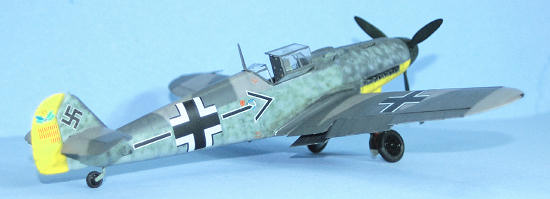 back to
the windscreen. The caption
states that in September 1941, JG 26 got rid of all their bright markings,
the squadron badge, and the individual “scores” on the rudder.
Looking back again at the Hitchcock photos, which were identified as
being taken in December 1941, I realized that the dark color under the
overspray was the same gray tone as the canopy bracing. Bf-109Fs had their
canopies painted in RLM 74.
back to
the windscreen. The caption
states that in September 1941, JG 26 got rid of all their bright markings,
the squadron badge, and the individual “scores” on the rudder.
Looking back again at the Hitchcock photos, which were identified as
being taken in December 1941, I realized that the dark color under the
overspray was the same gray tone as the canopy bracing. Bf-109Fs had their
canopies painted in RLM 74.
I suddenly understood
what it was: the nose had been painted yellow, with the lower cowling panel
left yellow for the standard Luftwaffe ID marking on the Channel Front, and
then painted over with RLM 74, which was then oversprayed, most likely with
RLM 76 light blue, and then with RLM 02 gray-green and RLM 70 black-green,
since these were the colors used on the fuselage mottle.
With that in mind, all
became easy. I pre-shaded the
model with flat black over the panel lines, then painted the lower cowling
and rudder with Xtracrylix Yellow 04, which I masked off when dry.
I then applied RLM 74 over the cowling, then painted the model
freehand with Xtracrylix RLM 76, which I blotched over the nose, I followed
that with the “mottle” of RLM 02 and RLM 70, I finished with the upper
camouflage of RLM 74 and RLM 75.
If you are doing a
Bf-109F-2 as I did here, remember to paint the main gear legs Red 23, which
was used to distinguish aircraft to the ground crews that required C-3
96-octane fuel rather than the standard 87-octane.
Decals:
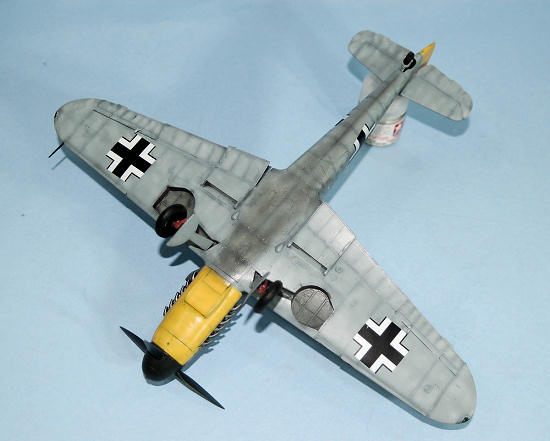 I used
the Techmod decals for Galland’s Bf-109E-4 to get the Geschwader Kommodore
“arrow,” and the “Mickey Mouse,” which were the only personal markings the
airplane carried according to the photos.
While by December 1941, everyone else in JG 26 had removed their
scores and awards from the rudder, Galland had kept his, which included the
Eichenlaub and 25 additional kill markings, all of which were pieced
together from the Techmod sheet and various other Luftwaffe decal sheets.
I used the kit insignia, and stenciling from a Lifelike Decals sheet.
Everything went down easily with Micro-Sol.
I used
the Techmod decals for Galland’s Bf-109E-4 to get the Geschwader Kommodore
“arrow,” and the “Mickey Mouse,” which were the only personal markings the
airplane carried according to the photos.
While by December 1941, everyone else in JG 26 had removed their
scores and awards from the rudder, Galland had kept his, which included the
Eichenlaub and 25 additional kill markings, all of which were pieced
together from the Techmod sheet and various other Luftwaffe decal sheets.
I used the kit insignia, and stenciling from a Lifelike Decals sheet.
Everything went down easily with Micro-Sol.
| FINAL ASSEMBLY |
The photos show this airplane to be in excellent condition, with a “satin” finish that may be the result of the ground crew polishing the airplane. Given it was the Geschwader Kommodore’s airplane, I am sure there were no dings anywhere, so the model was given a coat of Xtracrylix “Satin” varnish, and exhaust and oil stains were added with Tamiya “Smoke” so the model looked like an operational airplane. I then attached the landing gear, prop and canopy, where I discovered that the main gear appears to have been molded at maximum extension, weight-off, which is the same mistake Eduard made. The solution is to reduce the length of the oleo by about a sixteenth of an inch. The exhausts also appear to stick out a bit far, which may be more due to my attaching the engine part I used to mount the exhausts too shallow inside the cowling.
| CONCLUSIONS |
So, can the Trumpeter
kit be turned into a Bf-109f-2? Yes.
Is the kit “fatally flawed”? No.
Is it “unbuildable”? No.
Does it require some extra effort?
That’s a definite “yes!”
But it needs a lot less extra effort if you decide to build the kit as what
it really is: a Bf-109G.If, however, what you want is a Bf-109F-4, then wait
for the Hasegawa kit, which is just in release this week, and which looks
from photos of the sprues to have gotten everything right for the
Friedrich series. The Aires
Bf-109F-2 resin conversion will work there if you want the earlier airplane.
Review kit courtesy of
my wallet thanks to James Reagan.
Copyright ModelingMadness.com.
If you would like your product reviewed fairly and quickly, please contact the editor or see other details in the Note to Contributors.
Back to the Review Index Page 2020